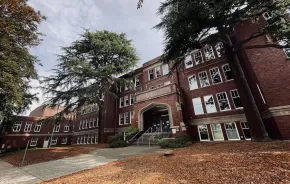
If you have a child attending school in the Seattle Public Schools (SPS) district, there’s a good chance you may already have met the district’s newest superintendent, Denise Juneau. In her office at district headquarters at the John Stanford Center for Educational Excellence in Seattle, it is community outreach and connection that have guided much of her action in her first year as leader of Seattle Public Schools.
“This past year was really a learning year for me, coming to a new city, a new district,” says Juneau. “We’re building a longer table, not a higher wall. We want to make sure we’re getting voices that traditionally have not been at the table.”
In order to hear from as many community members as possible, she’s visited all 102 schools in the district; formed a student advisory board composed of diverse students from across the district; and embarked on a “Listening and Learning” tour during which she spoke with more than 2,500 people on 21 stops.
Juneau says she’ll use what she’s learned as she moves forward in working to improve learning outcomes for Washington state’s largest K–12 school district, which serves more than 53,000 students district-wide.
If anyone can do it, it’s Juneau. As an enrolled member of the Mandan, Hidatsa and Arikara Nation and a descendant of the Blackfeet tribe and the Tlingit and Haida tribes, Juneau attended Browning High School, located on the Blackfeet Indian Reservation in Montana. Her learning journey is an admitted “Head Start to Harvard” story, which culminated in her earning a Master of Education degree from the Harvard Graduate School of Education and a law degree from Montana State University. She was the first American Indian woman in the United States to be elected to an executive statewide office, as superintendent of public instruction in Montana, where she garnered a reputation for working with community stakeholders to improve educational outcomes. She also is credited with increasing graduation rates by 5 percentage points for all students and 8 percentage points for Native American students.
The goal: intentionally, authentically engage communities of color.
Yet she’s entered Seattle Public Schools at a particularly challenging time. It’s no secret that the Seattle school district currently has one of the largest opportunity gaps in the nation, especially with respect to the gulf between black and white student achievement. At the start of the 2018–2019 school year, in SPS schools alone, more than 4,000 students were homeless. In addition, schools in the district have been under fire for everything from cutting programming for Native American students to administering state testing during Ramadan.
Juneau is the first to admit there are plenty of challenges ahead and that many Seattle families are skeptical that real change is possible. “Seattle is a place that talks a lot about race and equity,” says Juneau, but her goal is to “intentionally, authentically engage communities of color.”
“There are no broken children,” Juneau insists. “There are only broken systems. So, we need to look internally at what it is about our systems that is not meeting the needs of communities of color and the students who are coming through our doors.”
To do so, says Juneau, she’ll focus on meeting the practical needs of families.
First, she’s focusing on improving transportation services, which have traditionally been a challenge. “How do we play with all the mobility efforts that are already going on around the city?” Juneau asks. She has already begun discussions with the Seattle Department of Transportation, King County, Amazon, Microsoft, and even Uber and Lyft to address the needs of students in our city.
Nutrition services are a focus, too. “We hear a lot about cultural or religious minorities within our systems. So, during times of fasting, what does that look like for nutritional services? If students come from a certain culture, how can we develop a food service program that provides students what they need during those times when they have cultural needs? If students need a place to pray every day, how do schools help address that?” she asks.
As for instruction, the district has already adopted a new science curriculum and will work to improve reading proficiency by bolstering existing reading intervention efforts. However, Juneau argues, it’s not just learning that will need to happen in the classroom, but “unlearning,” too. Currently, 89 percent of SPS teachers are white, while more than 45 percent of students in the district are students of color. There are currently few guidelines to standardize the implementation of initiatives to diversify course curricula to be more representative.
According to Juneau, one of the primary concerns of the student advisory board is the importance of students seeing themselves reflected in their teachers and their texts. Juneau says more inclusive instruction will take time; the district will have to rethink current curricula, train staff and prioritize the hiring of more teachers of color.
There’s a lot of work to do, but Juneau seems hopeful that Seattle is up to the challenge. “Because of the city we’re in, we can actually be leaders in the country,” she says. “The thing about Seattle is we’re rich in money, we’re rich in intelligence, we’re rich in programs. We’re rich in a lot of different ways, and we just need to harness that and make sure that we’re working on the right issues.”











